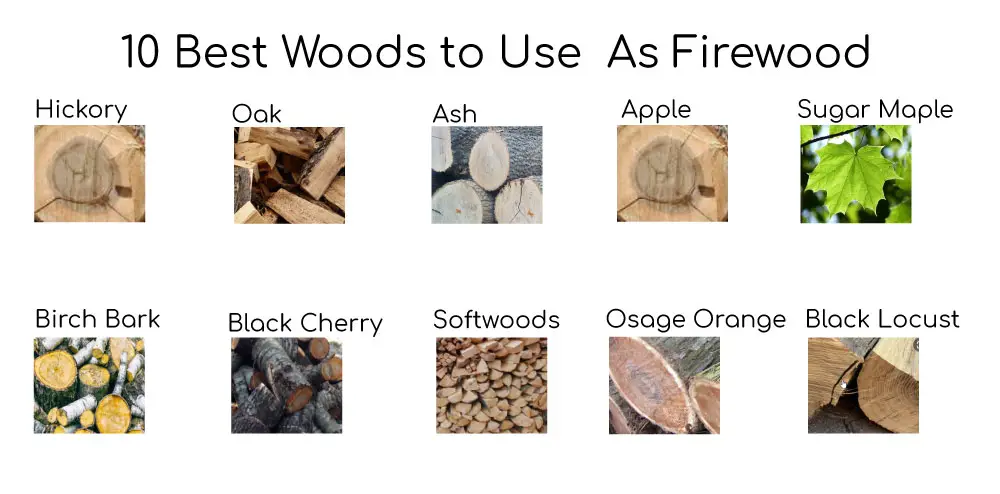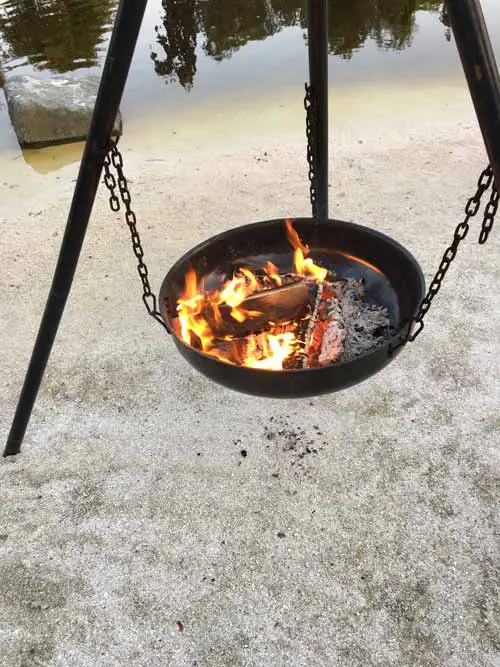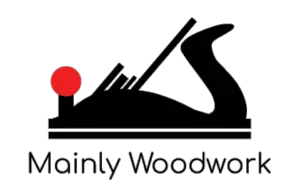Disclosure: This post may contain affiliate links, meaning I get a commission if you decide to make a purchase through my links, at no extra cost to you.
Choosing the right firewoods can be challenging. There are so many options to choose from and they differ a lot in how they burn, smell, and act. As general advice, I would say that you can burn the wood you have available, as long as it does not pose a health hazard.
But choosing the right type of wood for the right situations will improve your moments around the campfire, fireplace, wood stove, or fire pit. Choosing the right wood really does matter.
The best wood to use as firewood is Hickory, Oak, Elm, Ash, Maple, Birch Tinder, Cherry, Douglas-Fir, and other types of softwoods. Hardwoods usually burn long and strong and softwoods burn quickly and aggressively.

Criteria For Good Firewood
To understand what constitutes good firewood we need to get to know what we are qualities we look for in firewood. Density, moisture content, heat output, availability, smoke, amount of resin in the wood, and the fragrance of the wood are all criteria we need to consider when choosing firewood.
The moisture content will depend on how the wood is seasoned and the availability will depend on the area, state, and country you live in.
Density
Dense woods burn longer and produce more heat relative to the size of the wood. Dense woods are most of the time considered as the preferable wood to use as firewood. Density will be measured in dried weight per square feet since that directly correlates with the density and is the most understandable.
Moisture Content (Seasoning)
The moisture content of firewood has to be low enough for the wood to burn efficiently. The moisture content of properly seasoned firewood should be below 20% and never higher than 25%. Seasoning firewood to this level can take as little as six months to two years depending on the conditions.
Heat Output
Heat output is very much related to the density of the wood. Heat output is measured in Heat Per Cord in Millions of BTUs. BTU is short for British Thermal Unit which is used to measure heat energy.
Availability
The availability of the different types of firewood in your area is important to what type of firewood you want to choose. A good example can be hickory wood, which is widely available if you live in the Eastern and Midwestern United States. But if you live in Europe, hickory is hard to come by and would be too expensive to use as firewood.
Smoke, resin, and Fragrance
When choosing firewood it is easy to overlook the amount of smoke the firewood produces, how much resin is in the wood, and the fragrance the wood gives when burned.
Birch keeps moisture underneath bark even seasoned and produces more smoke than other wood, pine has a lot of resin and can cause creosote buildup in chimney, and Eucalyptus wood smells like medicine when burned and are unpleasant for many people
All the factors above are important to consider, and the type of firewood you want to use depends on your situation and when you want to use it.

The Best Wood To Use As Firewood
1. Hickory
Hickory is good for so many things, and it is especially good as firewood. Hickory is considered by many to be one of the best types of wood for firewood. The density of Hickory makes the wood burn hot and the logs last for a long time. The hickory logs will burn throughout the night if you let them.
Due to the high density of hickory, it can be hard to get the fire started without any newspaper or fire starters. Use small pieces of hickory to get the fire started.
Hickory can be used in all situations where you need firewood. But it is best for fires that need to last for a long time and continually produce heat.
Hickory also dries faster than for example oak, so it can go quicker from felling to being ready to use as firewood.
Hickory is native to North America and can be found in abundance throughout Eastern and Midwestern United States
Density (Dry Weight): 48 lbs/ft3
Heat Output: 28 Heat Per Cord (Million BTUs)
Smoke, Resin, Fragrance: Produces very little smoke and has a sweet and savory smell.
2.Oak (White)
Oak is also one of the most preferred firewoods and is widely available across Northern America And Europe. In this article, I am using white oak as an example, but most oaks will have similar properties for burning.
White Oak burns amazingly well and burns hot without producing too much smoke. Oak is known for its long and steady burns and will burn similar to hickory.
Oak can be burned anywhere you can burn firewood. If you want a long and steady burn and don’t want to add logs every 10 minutes, then Oak is the way to go.
Oaks is known for taking a long time to dry. Getting well-seasoned Oak can take more than two years, and at a minimum of one year if small pieces are used. If you are producing your own firewood from Oak you have to start seasoning the wood as quickly as you can and be able to store the wood for a long time.
Density (Dry Weight): 47 lbs/ft3
Heat Output: 29.1 Heat Per Cord (Million BTUs)
Smoke, Resin, Fragrance: Oaks produces little smoke and has a mild fragrance.
3. Apple
Apple is highly priced by many people for firewood. It burns slow, has a great heat output, produces very little smoke, and produces a pleasant aroma when burned.
Because of the pleasant aroma the wood from the aple tree produces when burned it is often used for smoking meat, and it will give a unique taste to the meat.
Wood from apple trees is not widely available and can be hard to obtain. The best scenario is if you own land where apple trees grow and can harvest the wood. You can also buy wood from apple trees on Amazon, but it is not cheap compared to other woods.
Density (Dry Weight): 52 lbs/ft3
Heat Output: 27 Heat Per Cord (Million BTUs)
Smoke, Resin, Fragrance: Produces little smoke, pleasant aroma, and fragrance.

4. Ash (White)
Ash is excellent to use as firewood in any situation. It produces a solid amount of heat and burns for a good amount of time. Compared to hickory, oak, and apple, ash does not burn as long and produces a little less heat. But it is still on top of the list for woods to burn.
A great quality of Ash is that it is very easy to split. One stroke with the axe usually splits the logs in half and it is a joy to work with.
Ash also seasons and dries fairly quickly. So if you start seasoning the wood in spring, it might even be ready for the coming winter if the seasoning had been done properly.
Ash has been under attack by invasive species like the Emerald Ash Borer since 2002, which is a beetle that ruins the ability of the ash to transport nutrients up to its leaves. Resulting in many ashes standing tall but dead, these can be used for firewood. But the number of some Ash species is decreasing in large amounts.
Ash is available throughout North America and Europe.
Density (Dry Weight): 42 lbs/ft3
Heat Output: 24.2 Heat Per Cord (Million BTUs)
Smoke, Resin, Fragrance: Subtle aroma, little smoke
5. Sugar Maple
Many people prefer sugar maple as firewood over oak and hickory even though sugar maple has a lower density than both of them. Sugar Maple affords a long-lasting flame with decent heat output.
Sugar maple produces a fair amount of smoke when burned. This can make it annoying if you use Sugar Maple in a fire pit with people sitting around. Don’t use sugar maple if you need the smoke to be at a minimum.
Sugar maple is also good for smoking meat due to the high sugar content in the wood and smoke it produces when burned.
In general, all types of maple can be used as firewood. Sugar Maple is just the species that burn the longest and strongest of the maple species. A great thing about the Maple species is that it is so widely available across North America and Europe.
Density (Dry Weight): 44.0 lbs/ft3
Heat Output: 25.5 Heat Per Cord (Million BTUs)
Smoke, Resin, Fragrance: Mild Smell, Some say it smells like maple syrup, medium amounts of smoke
6. Birch (Tinder)
The wood from the birch tree is just an average wood burn. It will output a fair amount of heat and burn longer than most softwoods. Birch produces a little bit of smoke when burned, because of water that stores underneath the bark which is hard to season.
Where birch excels, is when we use the bark of the birch as tinder and a firestarter. Birch bark peels of the birch in layers as it grows. This old bark can is as dry as dust and can be used as an excellent fire starter. Simply peel off some birch bark when you are out camping or you are just lighting a fire in the forest, and you will have a reliable fire starter.
Birch has a tendency to rot and getting infected by fungi fairly quickly if not split into smaller pieces and seasoned properly. If you are using the wood of the birch as firewood, make sure it is properly seasoned and those bigger trunks are split into smaller pieces.
Density (Dry Weight): 40 lbs/ft3
Heat Output: 20.8 Heat Per Cord (Million BTUs)
Smoke, Resin, Fragrance: medium amounts of smoke, slightly sweet aroma when burned

7. Black Cherry
The most unique quality of black cherry is the pleasant and sweet smell emerging from the wood burned. Nothing can beat the smell of a cherry fire in the morning.
Cherry is not as common to use as popular woods like hickory and oak. But it sure can make a good fire, though it will not burn as long and as strong. But it will surely be sufficient to heat up your home.
Because of the good smell and the small amounts of smoke it produces, cherry is one of my favorite woods to use around campfires.
Cherry is also one of the woods most used to smoke meat, because of the light and sweet taste it gives to the meat it can be used to smoke all meats.
Density (Dry Weight): 35 lbs/ft3
Heat Output: 20.4 Heat Per Cord (Million BTUs)
Smoke, Resin, Fragrance: Known for a pleasant and unique aroma, Produces little smoke
8. Douglas Fir and Other Softwoods
Among the softwoods, Douglas-Fir is the one most suitable. It burns a little bit quicker than most of the hardwoods but it will still burn for some time before you need to throw on more logs. So if you have a lot of douglas fir, why not use it.
Wood from softwoods is great for kindling and starting fires because of the lower density. So if you like to add sticks and logs to the fire, then softwoods are great.
Pine, Spruce, and other softwoods can also be burned. But softwoods usually have a lot of sap and resin stored in the wood. The sap will produce smoke when burned and can cause creosote to build up in the chimney. You can still use the softwoods as firewood, just be aware that you might have to clean the chimney more often if you burn a lot of softwoods.
The smoke from softwoods can also be annoying if the wind blows the smoke in your face when sitting around the campfire. Your eyes might hurt a little bit from the smoke, but the smoke is not dangerous if it’s only in small amounts.
The reason I add these softwoods to the list is that in some places, softwoods like pine and spruce are the only trees that are available for firewood, and hardwoods like oak are in short supply. I just want to show that you can still use softwoods. In fact, where I live in Western Norway we mostly use Sitka Spruce just because we have a lot of it.
Density (Dry Weight): 32 lbs/ft3
Heat Output: 20.7 Heat Per Cord (Million BTUs)
Smoke, Resin, Fragrance: Smells like the needles on the tree, Large Amounts of Sap, Moderate to high amounts of smoke
9. Osage Orange
The best firewood list would not be complete without Osage Orange on the list.
Osage Orange is an extremely dense wood and still grows really quickly, which makes it great for firewood. But you have to be careful when burning Osage Orange, it is so dense and can burn so hot that it damages your fireplace.
Osage Orange is best burned in combination with other woods to minimize the effects of it burning too hot. The wood contains good amounts of sap which produces a lot of sparks when burned. Be careful when burning Osage Orange, especially inside.
Density (Dry Weight): 54 lbs/ft3
Heat Output: 32.9 Heat Per Cord (Million BTUs)
Smoke, Resin, Fragrance: High Amounts of smoke, high amounts of sap, Citrusy fragrance
10. Black Locust
Black locust is an excellent wood for firewood. It is one of the densest woods we use for firewood and it even has a little bit better heat output than the wood of the great hickory tree.
Black locusts will burn long and strong and keep burning long into the night. So if you want a fire that you don’t want to attend too far too often, black locust is a great choice.
The wood will produce little smoke when burned and produces some sparks but not a lot.
So if you can get your hands on some black locust I would recommend it.
Density (Dry Weight): 48 lbs/ft3
Heat Output: 28.1 Heat Per Cord (Million BTUs)
Smoke, Resin, Fragrance: low amounts of smoke, little fragrance to the wood
References:
